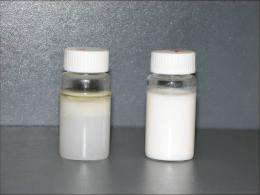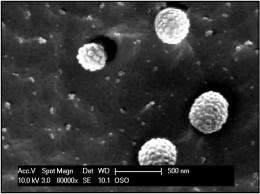Nano-sand to improve lotions and cosmetics

South Australian researchers have invented and patented a new technology for delivering cosmetics and drugs to the skin. They are using nanoparticles of silica (essentially sand) to create longer lasting cosmetics and creams that control the delivery of drugs through the skin.
They already have a family of international patents on their technology, and are now actively looking for commercial partners to get their invention out of the lab and on to your skin.
“We are using specially engineered nanoparticles of silica—so small that about a thousand of them could fit across a human hair—to create the emulsions on which many cosmetic and therapeutic products are based,” says Nasrin Ghouchi-Eskandar from the University of South Australia’s Ian Wark Research Institute.
The work is being presented for the first time in public through Fresh Science, a communication boot camp for early-career scientists held at the Melbourne Museum. Nasrin was one of 16 winners from across Australia.
Many liquids we take for granted—milk, paint, salad dressings, skin creams—are actually emulsions, tiny droplets of oily compounds dispersed in water. These are typically created using surfactants or detergents, but Nasrin and her colleagues have developed emulsions in which silica nanoparticles—miniscule grains of sand—coat the oil droplets instead.
“Coating the tiny emulsion droplets with silica increases the stability of the mixture, and makes it less likely that the active compounds inside will degrade or be released until we want it to happen, says Nasrin. “These are two significant challenges for formulation scientists.”
“Using our method, we found that, from a clinical point of view, drug delivery can be improved by adjusting release through the thickness of the coating. We can prepare both fast release, and slow or controlled release delivery systems.”

This could be really beneficial if a drug has to be released at a specific time, or if releasing too much at once can lead to accumulation and toxic effects.
“It turns out that silica nanoparticles interact with skin cells in a way which increases the delivery of drugs to specific skin layers significantly,” says Nasrin. “Using the nanoparticles, not only was a higher concentration of the active ingredient delivered, but also leakage into the blood stream was limited. This is a great advantage for skin creams like sunscreens, for instance. It limits exposure of the rest of the body, and any consequent toxicity.”
“And nanoparticle-coated emulsions are cost-effective, because they are efficient at delivering drugs. A smaller quantity of active compound can be used in a more stable form. And we are working to ensure they are safe,” Nasrin says. “We have shown that they will not pass through pig skin. In the near future we will be moving to trials using human skin.”
Provided by Fresh Science
















